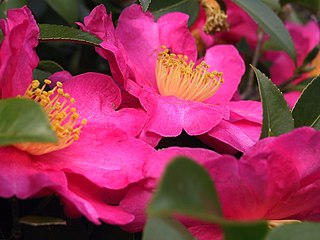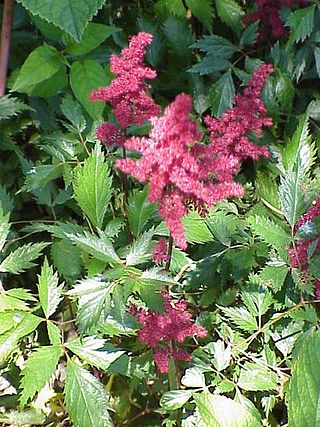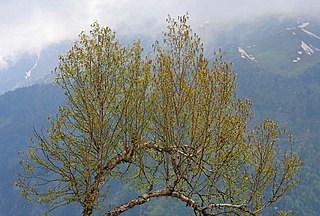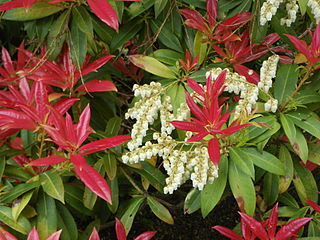
Camellia is a genus of flowering plants in the family Theaceae. They are found in tropical and subtropical areas in eastern and southern Asia, from the Himalayas east to Japan and Indonesia. There are more than 220 described species. Camellias are popular ornamental, tea and woody-oil plants that have been cultivated throughout the world for centuries. To date, over 26,000 cultivars, with more than 51,000 cultivar names including synonyms, have been registered or published.

Veronica sect. Hebe is a group of plants within the genus Veronica, native to New Zealand, Rapa in French Polynesia, the Falkland Islands and South America. It was formerly treated as the separate genus Hebe. It includes about 90 species. Almost all species occur in New Zealand, apart from Veronica rapensis and Veronica salicifolia, found in South America. It is named after the Greek goddess of youth, Hebe. Informally, species in the section may be called shrubby veronicas or hebes.

Primula is a genus of herbaceous flowering plants in the family Primulaceae. They include the primrose, a familiar wildflower of banks and verges. Other common species are P. auricula (auricula), P. veris (cowslip), and P. elatior (oxlip). These species and many others are valued for their ornamental flowers. They have been extensively cultivated and hybridised. Primula are native to the temperate Northern Hemisphere, south into tropical mountains in Ethiopia, Indonesia, and New Guinea, and in temperate southern South America. Almost half of the known species are from the Himalayas.

Forsythia, is a genus of flowering plants in the olive family Oleaceae. There are about 11 species, mostly native to eastern Asia, but one native to southeastern Europe. Forsythia – also one of the plant's common names – is named after William Forsyth.

Cryptomeria is a monotypic genus of conifer in the cypress family Cupressaceae. It includes only one species, Cryptomeria japonica. It used to be considered by some to be endemic to Japan, where it is known as Sugi. The tree is called Japanese cedar or Japanese redwood in English. It has been extensively introduced and cultivated for wood production on the Azores.

Dasiphora fruticosa is a species of hardy deciduous flowering shrub in the family Rosaceae, native to the cool temperate and subarctic regions of the northern hemisphere, often growing at high altitudes in mountains. Dasiphora fruticosa is still widely referenced in the horticultural literature under its synonym Potentilla fruticosa. Common names include shrubby cinquefoil, golden hardhack, bush cinquefoil, shrubby five-finger, widdy, kuril tea and tundra rose.

Hydrangea macrophylla is a species of flowering plant in the family Hydrangeaceae, native to Japan. It is a deciduous shrub growing to 2 m (7 ft) tall by 2.5 m (8 ft) broad with large heads of pink or blue flowers in summer and autumn. Common names include bigleaf hydrangea, French hydrangea, lacecap hydrangea, mophead hydrangea, and hortensia. It is widely cultivated in many parts of the world in many climates. It is not to be confused with H. aspera 'Macrophylla'.

Wisteria floribunda, common name Japanese wisteria, is a species of flowering plant in the family Fabaceae, native to Japan. Growing to 9 m (30 ft), Wisteria floribunda is a woody, deciduous twining climber. It was first brought from Japan to the United States in the 1830s. It is a common subject for bonsai, along with Wisteria sinensis.

Andromeda polifolia, common name bog-rosemary, is a species of flowering plant in the heath family Ericaceae, native to northern parts of the Northern Hemisphere. It is the only member of the genus Andromeda, and is only found in bogs in cold peat-accumulating areas. Andromeda glaucophylla is a synonym of A. polifolia var. latifolia.

Camellia japonica, known as common camellia, or Japanese camellia, is a species of Camellia, a flowering plant genus in the family Theaceae. There are thousands of cultivars of C. japonica in cultivation, with many colors and forms of flowers. Despite its common name, it is native to China, not Japan. The cultivation of Camellia japonica also started in China. Its widespread cultivation can be traced back to the Song Dynasty, when 15 varieties of Camellia japonica were recorded in literature. It was later introduced to Japan. It grows in forests, at altitudes of around 300–1,100 metres (980–3,600 ft).

Weigela is a genus of between six and 38 species of deciduous shrubs in the family Caprifoliaceae, growing to 1–5 m (3–15′) tall. All are natives of eastern Asia. The genus is named after the German scientist Christian Ehrenfried Weigel.

Kerria japonica, commonly known as Japanese kerria or Japanese rose, is a deciduous, yellow-flowering shrub in the rose family (Rosaceae), native to China, Japan and Korea. It is the only species in the genus Kerria. In the wild, it grows in thickets on mountain slopes. Japanese kerria has been used for medicine and is also planted in gardens. A double-flowered cultivar, K. japonica 'Pleniflora', is commonly called bachelor's buttons.

Astilbe is a genus of 18 species of rhizomatous flowering plants within the family Saxifragaceae, native to mountain ravines and woodlands in Asia and North America. Some species are known by the common names false goat's beard and false spirea.
Fetterbush is a common name for several plants in the family Ericaceae, and may refer to:

Spiraea japonica, the Japanese meadowsweet or Japanese spiraea, is a plant in the family Rosaceae.

Pieris japonica, the Japanese andromeda or Japanese pieris, is a species of flowering plant in the heath family Ericaceae. It is native to eastern China, Taiwan, and Japan, where it grows in mountain thickets. This medium-sized evergreen shrub or tree is widely cultivated in gardens.

Betula utilis, the Himalayan birch, is a deciduous tree native to the Western Himalayas, growing at elevations up to 4,500 m (14,800 ft). The Latin specific epithet utilis means "useful", and refers to the many uses of the different parts of the tree. The white, paper-like bark was used in ancient times for writing Sanskrit scriptures and texts. It is still used as paper for the writing of sacred mantras, with the bark placed in an amulet and worn for protection. Selected varieties are used for landscaping throughout the world, even while some areas of its native habitat are being lost due to overuse of the tree for firewood.

Acer palmatum, commonly known as Japanese maple, palmate maple, or smooth Japanese maple (Korean: danpungnamu, 단풍나무, Japanese: irohamomiji, イロハモミジ, or momiji,, is a species of woody plant native to Korea, Japan, China, eastern Mongolia, and southeast Russia. Many different cultivars of this maple have been selected and they are grown worldwide for their large variety of attractive forms, leaf shapes, and spectacular colors.

Pieris floribunda is a North American species of broadleaf evergreen shrub, a member of the fetterbush genus in the blueberry family (Ericaceae). It is commonly known in North America as mountain fetterbush or mountain andromeda. All parts of Pieris floribunda are poisonous if ingested. In landscapes it should be grown in full to part shade, out of windy locations, and have a good quality soil with much organic matter with acidity of pH 4.5 to 6.5.

Pieris formosa, called the Taiwan pieris or the Himalayan andromeda, is a species of flowering plant in the genus Pieris native to Nepal, the eastern Himalaya, Assam in India, Myanmar, Vietnam, Tibet, central and southern China, but not Taiwan. The 'Wakehurst' cultivar of the variety Pieris formosa var. forrestii has gained the Royal Horticultural Society's Award of Garden Merit as an ornamental, and is also considered by them as a good plant to attract pollinators. A vigorous evergreen shrub to 4 m (13 ft) in height, its leaves open red in early spring, turning green later. The trusses of creamy white flowers open at the same time as the young leaves. Like all pieris, it prefers a partially shaded spot in acid pH soil.




















